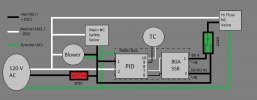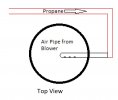Yes.
The LOW flow by-pass is manually adjusted by the LOW needle valve to run the forge about 100° below the desired temperature ( 1400°F is a good spot). This level of gas is always flowing. Consider it the idle flame setting.
The HIGH flow is turned on and off by the solenoid. With the solenoid in the open position (by turning the solenoid switch to SET *) you adjust the HIGH needle valve to run the forge above the desired target (say, 1700°F if doing HT). The high level is extra gas provided by the solenoid when a little more heat is needed. Instead of slamming the forge into max burner output every time the solenoid turns on, it gently adds more heat.
When the PID is set to the desired target (as long as it is within the pre-setting range) the flame will cycle from LOW to HIGH. This keeps the max-high and min-low fairly close and the controller does a better job of keeping the temp tight.
* I added a switch that turns the solenoid ON and holds it open. This allows setting the HIGH level without having to change the PID target like my old instructions said. After setting the HIGH level max, turn this switch RUN.



